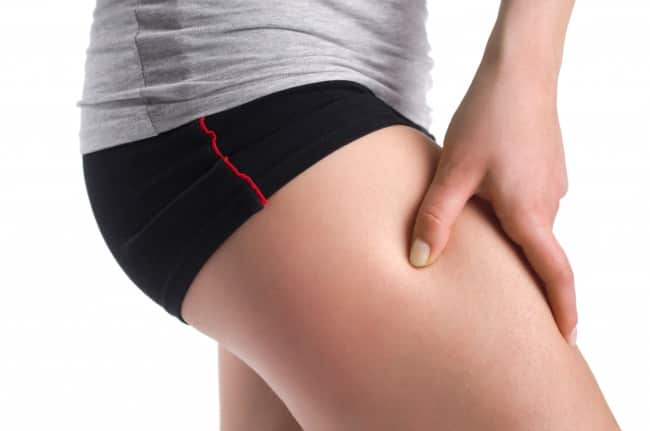
Inflammation of the thigh
Inflammation of the thigh can occur due to several causes. Typical symptoms of inflammation of the thigh are local swelling, reddish irritated skin and pain on pressure. An inflammation (mild inflammatory response) is a normal natural response when soft tissues, muscles or tendons become irritated or damaged. When tissue is damaged or irritated, the body will try and increase blood circulation to the area - this leads to pain, local swelling, heat development, reddish skin and pressure soreness. The swelling in the area can also lead to a nerve compression, which we can see, among other things, by squeezing the sciatic nerve in the seat or hip area. These symptoms will vary in intensity depending on the damage or irritation in the tissue. It is important to distinguish between inflammation (inflammation) and infection (bacterial or viral infection).
Causes of inflammation of the thigh
As mentioned, inflammation or inflammation is a natural response from the immune system to repair an injury or irritation. This may occur due to overuse (without sufficient stability muscle to perform the task) or due to minor injuries. Here are some diagnoses that can cause inflammation or inflammation of the thigh:
Arthritis (Arthritis)
Osteoarthritis (the pain depends on which joints are affected)
Iliopsoas bursitis (hip, groin mucosal inflammation)
Muscle tension in the thigh
nerve Irritation
Prolapse of the lumbar spine
rheumatism (the pain depends on which joints are affected)
Quadriceps muscle damage or tearing
Who is affected by inflammation of the thigh?
Absolutely everyone can be affected by an inflammation in the thigh - as long as the activity or load exceeds what the soft tissue or muscles can withstand. Those who increase their training too fast, especially in jogging, sports, weightlifting and especially those with a high repetitive load on weight-bearing joints are most exposed - especially if the majority of the load is on a hard surface. For weak support muscles (hip, back and buttock muscles, among others) in combination with incorrect postures in the feet (overpronation and flatfoot) can also be a contributing cause of developing an inflammatory reaction in the thigh.
Inflammation of the thigh can be very troublesome and can lead to pain and problems also in nearby structures. If an inflammation occurs, you must keep in mind that in most cases it is self-inflicted (overuse or a lot of walking on hard surfaces with a lack of training of supporting muscles, for example?), And that you are smart in listening to what the body is trying to do. tell you. If you do not listen to the pain signals, the condition or structure can be chronically damaged. Our advice is that you seek active treatment (eg chiropractor, physiotherapist or manual therapist) for the problem.
Symptoms of inflammation of the thigh
Pain and symptoms will depend on the extent to which the thigh has an inflammatory reaction. We remind you again that an inflammation and an infection are two completely different things - if you get a severe inflammatory reaction with heat development, fever and pus in the area, then you have an infection, but we will go into more detail in another article. Typical symptoms of inflammation include:
- Local swelling
Reddish, irritated skin
- Painful when pressing / touching
Diagnosis of inflammation of the thigh
A clinical examination will be based on a history / anamnesis and an examination. This will show reduced movement in the affected area and local tenderness. You will not normally need further imaging - but in certain cases it may be relevant with imaging to check if an injury is the cause of the swelling or possibly also blood tests.
Diagnostic examination of inflammation of the thigh (X-ray, MRI, CT or ultrasound)
An X-ray can rule out any fractures to the femur or hip. One MRI examination can show if there is any damage to tendons or structures in the area. Ultrasound can examine whether there is tendon damage - it can also see if there is fluid accumulation in the area.
Treatment of inflammation of the thigh
The main purpose of treating inflammation in the thigh is to remove any cause of the inflammation and then let the thigh heal itself. As mentioned earlier, an inflammation is a completely natural repair process where the body increases blood circulation to the area to ensure faster healing - unfortunately it is the case that sometimes the body can do a slightly excessive job and it may then be necessary with icing, anti- inflammatory laser and possible use of anti-inflammatory drugs (we remind you that overuse of NSAIDS can lead to reduced repair in the area). Cold treatment can provide pain relief for sore joints and muscles, also in the thigh. Blue. Biofreeze (opens in a new window) is a popular natural product. One should always try conservative treatment for a long time before resorting to invasive surgery (surgery and surgery), but in some cases this is the only way out. Direct conservative measures can be:
- Physical treatment (treatment of nearby muscles can provide pain relief and increased blood circulation)
- Rest (take a break from what caused the injury)
- Nedising / cryotherapy
- Sports taping / kinesio taping
- Insole (this can lead to a more correct load on the foot and sole - but is not a "quick fix" or good plan in the long run)
- Exercises and stretching (see exercises further down in the article)
What can I do even for muscle and joint pain?
1. General exercise, specific exercise, stretching and activity are recommended, but stay within the pain limit. Two walks a day of 20-40 minutes make good for the whole body and sore muscles.
2. Trigger point / massage balls we strongly recommend - they come in different sizes so you can hit well even on all parts of the body. There is no better self help than this! We recommend the following (click the image below) - which is a complete set of 5 trigger point / massage balls in different sizes:
3. Training: Specific training with training tricks of various opponents (such as this complete set of 6 knits of different resistance) can help you train strength and function. Knit training often involves more specific training, which in turn can lead to more effective injury prevention and pain reduction.
4. Pain Relief - Cooling: Biofreeze is a natural product that can relieve pain by cooling the area gently. Cooling is especially recommended when the pain is very severe. When they have calmed down then heat treatment is recommended - it is therefore advisable to have both cooling and heating available.
5. Pain Relief - Heating: Warming up tight muscles can increase blood circulation and reduce pain. We recommend the following reusable hot / cold gasket (click here to read more about it) - which can be used both for cooling (can be frozen) and for heating (can be heated in the microwave).
Recommended products for pain relief for muscle and joint pain
Biofreeze (Cold / cryotherapy)
Exercises for inflammation of the thigh
One should try to cut out too much weight-bearing exercise if one is afflicted with inflammation in the thigh - at least until the worst has been healed. Replace jogging with swimming, elliptical machine or exercise bike. Also make sure you stretch your hips, thighs, calves, soles of your feet and train your feet lightly as shown in this article. We also recommend that you try these quietly hip exercises.
Related article: - 10 Exercises for Bad Hips
NEXT PAGE: - Sore thigh? You should know this!
Recommended products for pain relief

Biofreeze (Cold / cryotherapy)

Also read:
- Pressure wave treatment of plantar fascite
- Exercises and stretching of plantar fascia heel pain
Popular article: - Is it tendonitis or tendon INJURY?
Most shared article: - New Alzheimer's treatment restores full memory function!
Training:
- Cross-trainer / ellipse machine: Excellent fitness training. Good for promoting movement in the body and exercising overall.
- Rowing Machines is one of the best forms of training you can use to get good overall strength.
- Spinning ergometer bike: Good to have at home, so you can increase the amount of exercise throughout the year and get better fitness.
Sources:
-
Thigh questions about inflammation:
Question: Female, football player, 20 years old. Inflammation of the right thigh I think, but how can I know if I have thigh inflammation / inflammation of the thigh?
In most cases, pain from joints and muscles is misinterpreted as 'inflammation'. This is a simplification of the problem that shifts the responsibility away from the person affected - and which suggests that it is not that person's fault. This is normally not the case - and most people have probably overloaded themselves over their ability (eg walking for several hours when you normally sit in the office all week) or done other things before they get such a pain presentation. The fact is that it is usually due to too little stability muscles, often in combination with stiff and dysfunctional joints in the pelvis and lower back - the pelvic joints are known to transfer weight from the lower body to the upper body, so it is important that these joints move sufficiently. A public health authorized clinician (chiropractor, physiotherapist or manual therapist) will be able to help you diagnose your ailment.
 Follow Vondt.net on YOUTUBE
Follow Vondt.net on YOUTUBE
(Follow and comment if you want us to make a video with specific exercises or elaborations for exactly YOUR issues)
 Follow Vondt.net on FACEBOOK
Follow Vondt.net on FACEBOOK
(We try to respond to all messages and questions within 24-48 hours. We can also help you interpret MRI responses and the like.)












Leave a reply
Want to join the discussion?Feel free to Contribute!